paintings 13
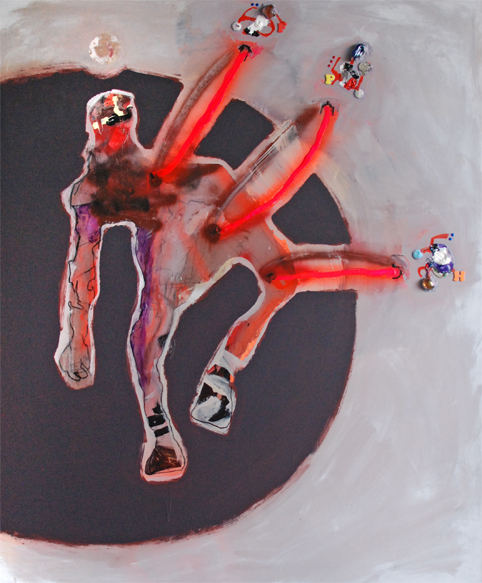
Mandala of grasping and clinging. Holding beliefs, clinging to emotions, clinging to feelings, clinging to things, clinging to the past, clinging to thoughts, clinging to ego. The letters "F", "P", "H" mark the symbols of the forms of samsara.
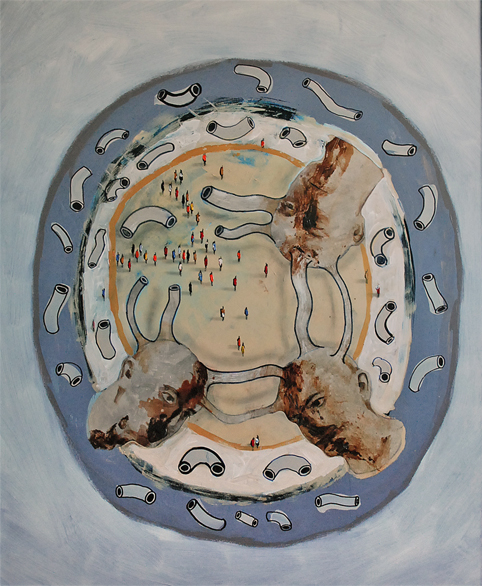
Mandala of awakening. Awakening is not a trance, insight or hallucination. It is not a realization, understood as the completion of the growth process (quantitative change). It is realization, making real. As transcendent - it is transcending and moving into another reality (qualitative change). Realization is the acquired ability to see things as they realistically exist. The tube-shaped elements symbolize Buddhist forms.
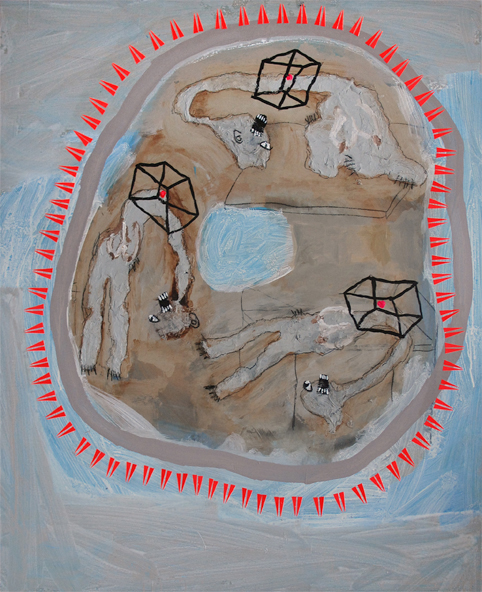
Mandala of one minute of suffering. Twenty-two forty-seven. She is insatiable, but only when hungry. Now approaching is a violation of loneliness for her. Out of fear of insecurity, she carried her daily fare wholesale to the man. Neurotransmitters in her brain where she rents rooms by the hour. Since her story fell apart. What nightly cramps pursued her and fell blows. Identification pours in pain after three times the incessant rape. She is not someone as she thinks of herself. She spoke to him. In the vicinity of the ego-excitement. He wants to! He litters and watches. He jerks and watches. Twentieth. Second. Forty. Eight.
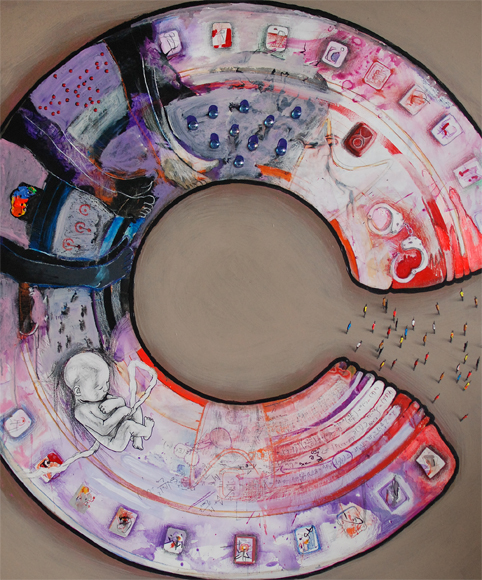
Mandala of humility - for entanglement. The hidden aspects in the unconscious are dual (marked with red dots). The Large Hadron Collider at CERN near Geneva confirms - Nietzsche was right - there is no good or evil. There are only collisions (marked with blue teardrops). My non-dual brain is exposed, anyone can pat it, spit or put out a cigarette.
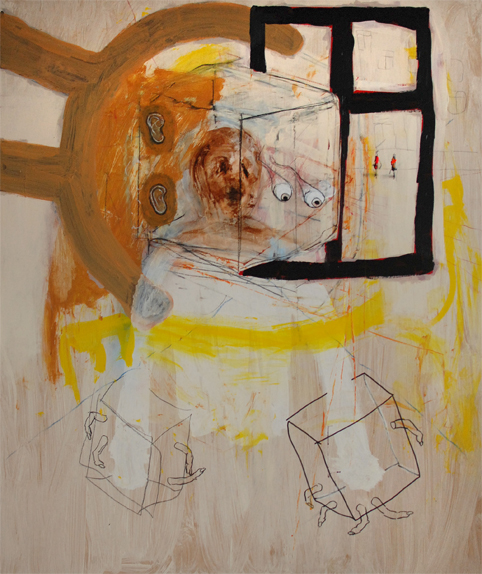
Five prerequisites for knowing Śunjata:
1. if you want to see Emptiness don't meditate with your eyes closed.
2. If you want to hear Emptiness don't meditate in silence.
3. If you want to feel Emptiness by touch don't meditate in solitude.
4. If you want to taste the Void don't meditate without food.
5. if you want to smell the Void don't meditate without smells.
1. if you want to see Emptiness don't meditate with your eyes closed.
2. If you want to hear Emptiness don't meditate in silence.
3. If you want to feel Emptiness by touch don't meditate in solitude.
4. If you want to taste the Void don't meditate without food.
5. if you want to smell the Void don't meditate without smells.
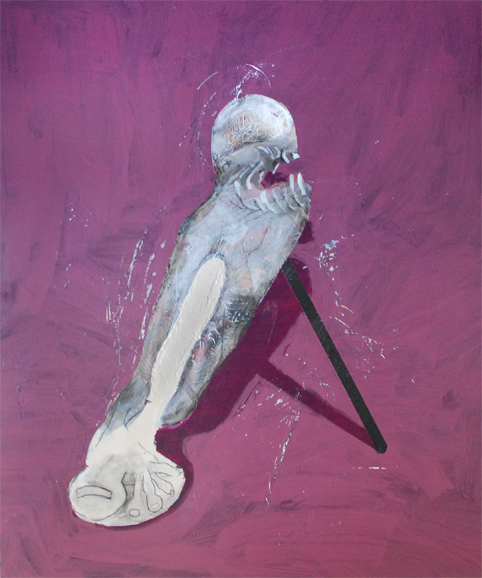
Brainfoot - ego visualization. I observe the ego after going out on the street. He is cold, I observe cold. And blood from the nose. I observe the blood. Red and heroic - a welcome introduction to humanism. Open veins shoot human hatred - by peripheral nerve under the spinous processes of the spine, it reaches from the bloated areas of the brain. Emptiness dissolves egress - according to the plutonium nucleus decay equation, when conscious gray cells in the brain finally implode.
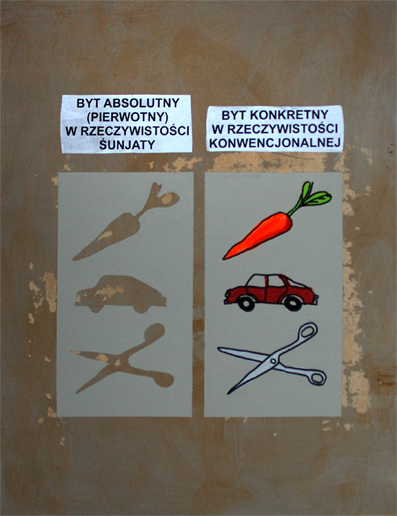
Absolute (primary) being as the basis of concrete being. When, on the ground of ontology, we talk about real existing things we are always talking about the existence of something concrete - the tree exists, I exist. Existence is always related to concepts. Something that has no properties cannot be said to exist. Even the claim "this exists" implicitly is always related to a concrete, realized object. Even when the mind does not have detailed knowledge of an object, it has knowledge of its visible properties. For example, when from a distance one does not know whether an object is a car or a rock, it is known that a large lump in black exists at a great distance. It is not possible to make an existential judgment about the existence of something that has no properties. The existence of a real thing is always related to the attribution of properties to things. It is a concrete entity. Ontology in general fails to recognize that being goes further, that the concept of being should be extended to include the being of things without properties. The being of things with properties is secondary to the being of things without properties. If we want to find out what being really is, we must go beyond the perception of ownership of objects. The perception of ownership of objects obscures the true essence of being, showing an already properly crafted image. Being in its purest form is visible when it is devoid of properties (including time). It is the basis of concrete being. It is absolute (primordial) being - being visible in Śunjata. Śunjata reveals the true form of being.
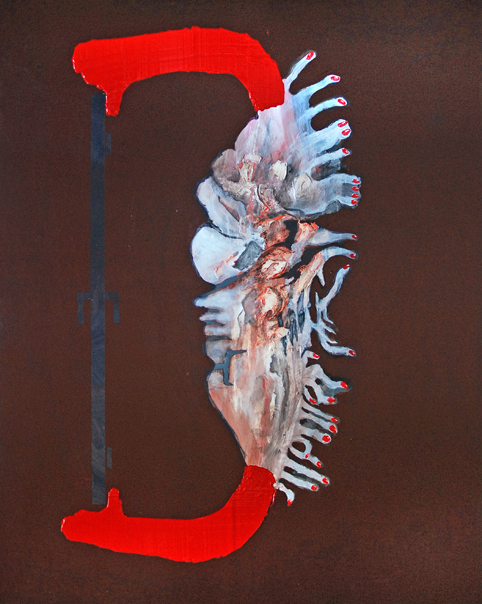
And all this with the door to Śunjata still closed. It is his hands that are Skłodowska-Curie's hands. Tides from above and below. The downward and upward tides. His fingers are the fingers of Poswiatowska and Karen Horney. The conscious takes pride in the jhanas. It grows in jhanas. A light bulb that shines amazingly luminous; a building that is beautifully tall; a car that is wonderfully drivable; rain that is remarkably drippy. A bicycle that impressively has two wheels and a sidewalk that is charmingly hard. And all this without a shadow of a metaphor. It is like a cross between Schrodinger and Schopenhauer seasoned with Abe Kobo.
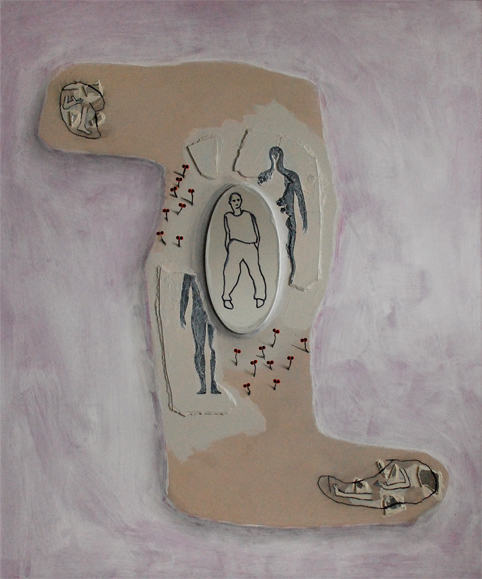
Self-portrait on a mirror, against a background of dualisms that do not have a mirror image (dualisms are marked in red). Who am I? In Śunjata, I am not an observer, because there is no one to observe. I am not a receiver of sensory stimuli, because there is no one to receive sensory stimuli. I am not even an uninvolved, non-participating, unfeeling, passive, silent, absent, mindless witness, because there is nothing that can be grasped as a witness. In the mind located in Śunjata, the external world perceived by the senses is reflected as in a mirror. The reflected image of external reality is devoid of form - meaning, distinction, judgment. It is only a filtered reflection, purified of properties. Apart from this reflection, nothing else can be found. In a mind where there is no inner Self, there is only the external world that fills it. Who am I when there is no conscious inner Self? I am all that is visible on the outside. Who am I? The external world.
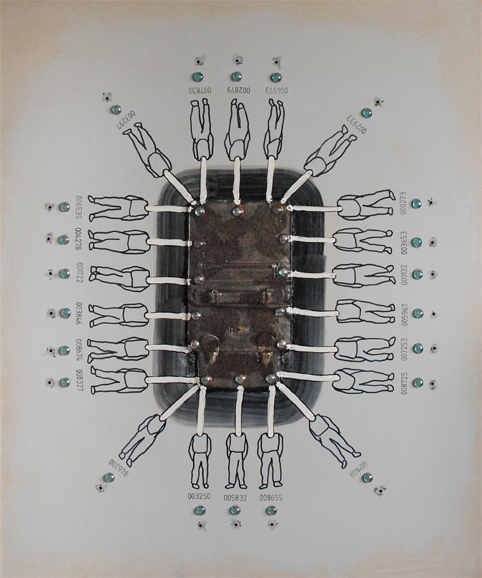
Mandala of the unchanging nature of Śunjata. A simultaneous representation of repeated attempts to know the true nature of things. The leather brown bag in Śunjata's reality is not a bag, it is not leather and it is not brown - it is a thing seen without form (without ownership and without time). Each time, the thing without form manifests in the same way - the nature of the leather brown bag - the nature of the thing without form - is the same in each experience of Śunjata. It is unchanging.
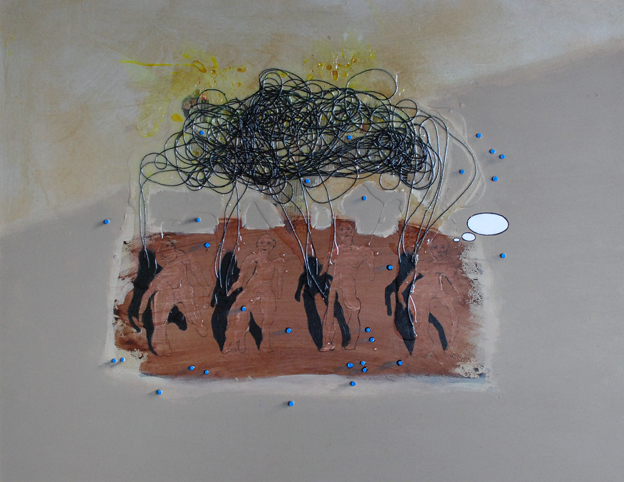
The concept of being in Śunjata. The concept of being in ontology does not transcend rational cognition, it does not transcend conventional reality. How then to define being in Śunjata reality, which is also a type of existence? Since existence is always related to concepts - "He exists," "They exist." - never transcends conventional reality. In Śunjata, concepts are not present, but this does not mean that existence is not observed in Śunjata. "He" and "They" are visible in Śunjata. Since they are visible, they cannot be non-being. It is existence without form. It is a purified existence - devoid of concepts (devoid of form). A thing that in conventional reality "exists as an object with properties" in Śunjata is "visible without properties." "Visible without property" as an eyesight is a singularity, having no counterpart in conventional reality. The existential judgment here is the process of seeing itself - the mirror image of the external world in the mind. The existential judgment taking the form of "the visibility of a thing - an object without property" is sufficient confirmation of the real existence of a thing. The confirmation of real existence is the very fact of presence in the visual field. (Buddhists define "existence" in Śunjata as "no longer being" but also "not yet nothingness.") Translation of the word "Śunjata" - devoid. The manifestation of the nature of Śunjata is marked in blue.
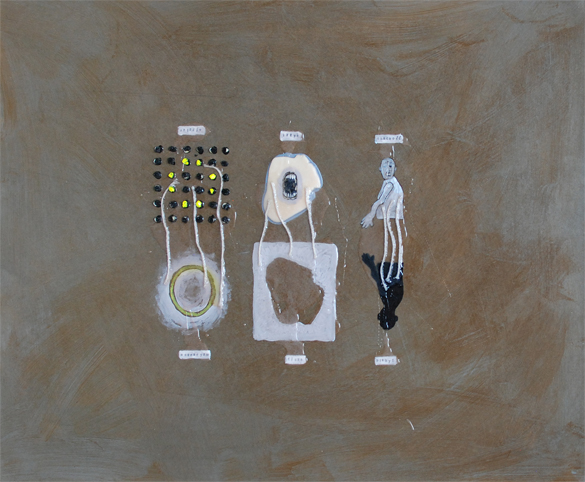
Dualisms. Invoking love creates hate, invoking gentleness creates cruelty, invoking presence creates non-being. In Śunjata reality, the forms of objects do not exist. If the properties of objects are not realized, dualisms - "relations-ostracism," "silence-cry" or "presence-nonexistence" - are not present either. The absence of dualisms is one of the characteristics of Śunjata.
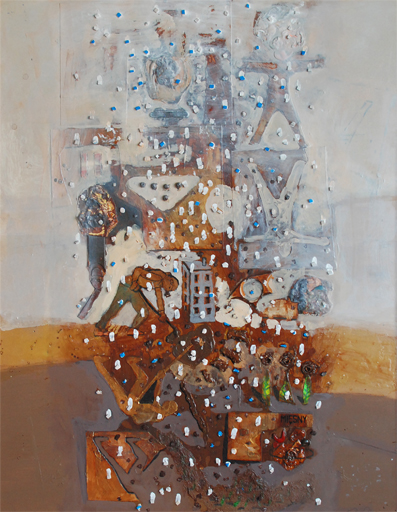
"Crystalline purity" as rain. To distinguish it from conventional reality, the reality of Śunjata is marked in blue. The property that characterizes the reality of Shunyata - "crystalline purity" - is an eye-pleasing property. It is one of the elements confirming entering into Shunyata and manifesting being in the Void. The property of "crystalline purity" is difficult to describe, because there is no analogous or even similar property in conventional (commonly experienced) reality, and there is no conceptual resource to do so. A certain approximation might be, not entirely aptly, a comparison to sharp vision with corrective glasses. In Shunyata's reality, however, the change is not a sharpening of the image in the field of vision, but a clearing of things and space of the obscuring "substance". It is the removal of the obscuring filter consisting of elements that affect the ultimate mental representation of conventional reality. We do not realize how much intangible entities (e.g., properties, concepts) affect the image of visible reality. These entities significantly change it. Conscious mind occupied with properties, concepts, judgment, analysis, marks the seen reality with its activity, giving it a specific essence. In everyday life we are not aware that we perceive this essence all the time. It is an immanent component of conventional reality (commonly experienced). This essence makes the reality we see as normal, in fact it is distorted, often illegible, obscured, scattered, disjointed, incomplete. Generally - dirty. This "dirt" is the mental representation of the obscuring: phenomena, properties and concepts. The removal of these distortions and dirtiness, as in Shunyata, is the basis for the emergence of the property of "crystal clarity". It is a visible property. It has its own strongly marked essentiality. It is one of the most important characteristics of the reality of Shunyata. But it is not purity understood as transparency of mental states. It is not purity understood as the absence of physical disturbance of the image. Describing it in terms available in conventional reality - it is clarity, unambiguity and distinctness. The property of "crystalline purity" is one of the elements that make up the specific, clearly visible essentiality of the reality of Shunyata.

Eternity as orange rain. The property that characterizes the reality of Shunyata - "eternity". In conventional reality, the mind never has access to experiencing eternity. Eternity is then a vague concept associated with infinity. The designator of eternity is never-ending existence. The concept of eternity is ultimately verified by the experience of Shunyata. In Shunyata it is the present moment. It is the ongoing "now". It is the endless process of the availability of the "now" - without the presence of the implicit anticipation of "then", without the implicit presence of "before". Eternity, however, is not a concept. It is an eyewitness property, an entity perceived visually. It is closely related to timelessness and created by this timelessness. The absence of time distorting the image of reality reveals one of the specific consistencies of Shunyata's reality - eternity. Eternity is seen as clear and strongly marked. It clearly imposes its character and shapes the visible reality. It gives it the essence of unshakable abiding in the here and now. It permeates all things. Things in their simplest form of existence are visible precisely in eternity. The reality of seeing eternity in the reality of Shunyata is complete. This reality (of the endless "now"), is at the same level of intensity and saturation as the reality of the existence of objects in conventional reality (commonly experienced). The vision of eternity is an immanent feature of Shunyata's reality, devoid of mystical references. There is no Shunyata without seeing eternity.
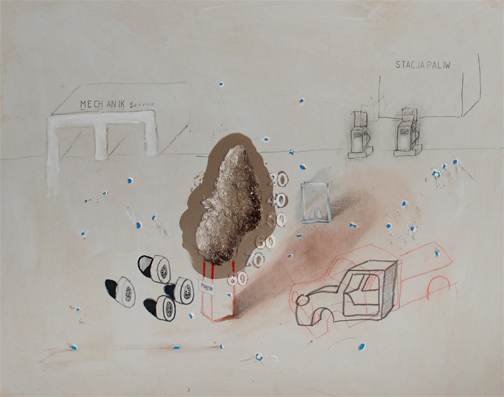
The car as a concept against the background of conventional reality. From this perspective, Shunyata is present but invisible. It is marked with blue elements to make the message clearer.
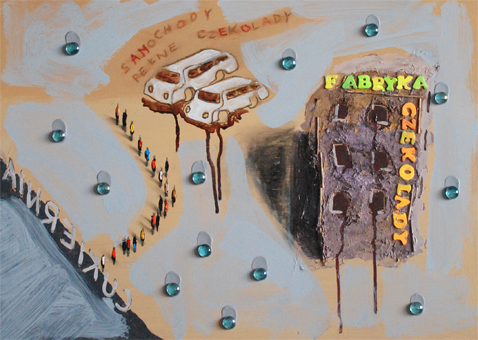
Cohsai the hermit, full of gratitude, humbly waits in line. Chocolate in Shunyata does not exist as chocolate. Although it is physically present, as a thing with the consistency of chocolate is visible. The substance has no chocolate taste, but it does not taste like a pickle, it just tastes like one. Just as it does not have a chocolate smell, but it does not smell like perfume, it just smells.
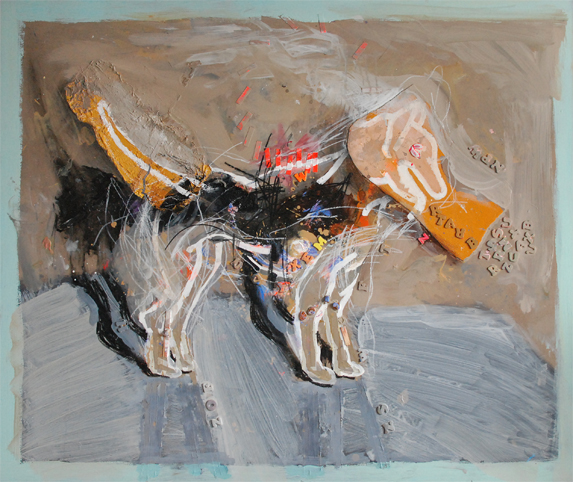
A dog-not-dog with a yellow-not-yellow tail-not-tail. In Shunyata reality, the dog does not have a torso, head, paws and tail but is a single entity - a dog-not-dog forming a unity with the external world. Existential judgment in conventional reality consists of a rational and an emotional part. The rational part is an invocation of concepts. An assertion like "a tree exists" is an assertion secondary to the act of cognition because of the use of two concepts, "tree" and "exists". In the cognitive act of existential judgment itself, there is an emotional component in addition to the recall of concepts previously known to the mind. The verb "exists" evokes an impulse, an emotion associated with affirmation. The nature of the existential judgment is the affirmative emotion evoked by the recall of concepts. Devoid of emotion, an existential judgment based only on the assertion "the tree exists" would be a mere reflection. Only the emotion of affirmation is a signal of affirmation of existence. However, both reflection and affirmation are secondary in the process of cognition of being because they are based on already established concepts. Existential judgment in conventional reality is a judgment about properties. It is an affirmation of the existence of conceptual-emotional relationship, not an affirmation of the existence of real being. The confirmation of the existence of a real entity is the act of pure seeing of that entity, without the conceptual and emotional component. In the reality of Shunyata, there is no need for incidental existential judgments, because existence in its pure form is confirmed all the time through permanent availability. In the reality of Shunyata, there are no properties of objects that absorb the mind and obscure real existence. In the absence of the visibility of the properties of objects, only their pure being is manifested. In conventional reality, the existential judgment is a false judgment of existence. The being of real existing things can only be seen in the reality of Shunyata - a dog-not-dog with a yellow-not-yellow tail-not-tail.
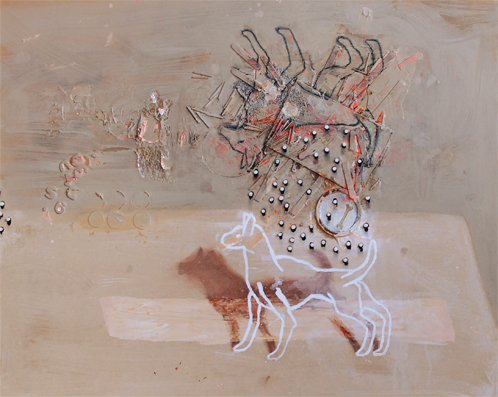
A thing that simultaneously is and is not a dog. In the reality of Shunyata, a dog is not a dog. In Shunyata the dog is not visible. Instead, the thing-not-dog is visible. The thing-not-dog in conventional being is a component of the one indivisible Great Being in the Shunyata. The existence of the non-dog is contained in the existence of all other things, and all other things are contained in the existence of the non-dog. The thing-not-dog is in billions, eons of other things, and the entire Universe is contained in the thing that is and is not-dog at the same time.
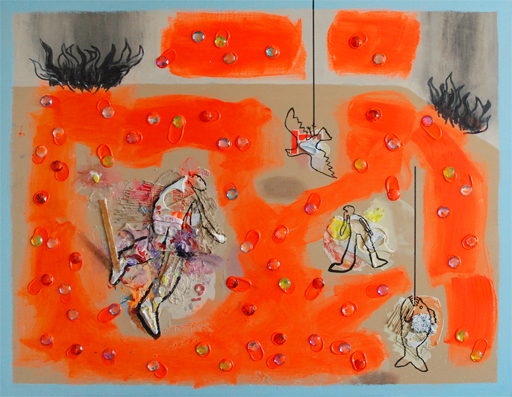
Excerpt from media reports from the perspective of Shunyata. Zbigniew S. does not lose his temper in the middle of a family argument and does not hit Margaret S., because in Shunyata there is no such thing as temper and hitting is not hitting. For the same reason Margaret S. does not become depressed, because depression does not exist in Shunyata. In an act of desperation, she does not kill her three children Antos, Matthew, and Olivia, because names do not exist in Shunyata. There are no children in Shunyata, and there is no such thing as killing. He does not set fire to his house and does not commit suicide because there is no fire in Shunyata and suicide does not exist.
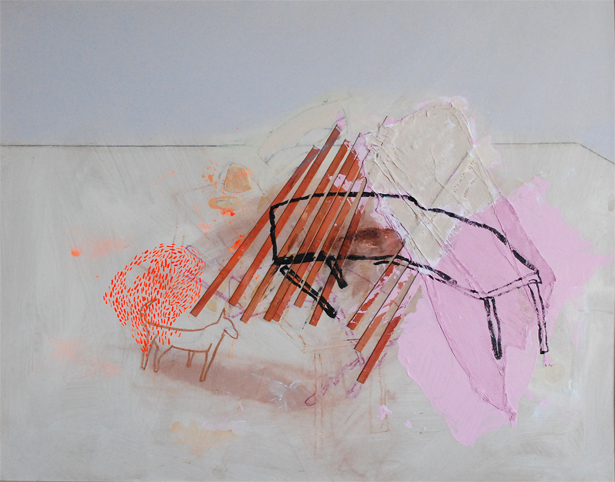
Interior with orange dog - how to imagine the reality of Śunjaty. Looking at the image, one must assume that the wooden table in the foreground is not a table and is not wooden. The purple tablecloth that lies on the table is not a tablecloth and there is no way it could be purple. The lamp standing on the table is not a lamp. Similarly, the painting hanging on the wall does not depict picturesque mountains, because it is not a painting and there are no mountains on it. A dog with orange fur is not standing at the table, because the drawn dog is not a dog and is not drawn and its fur is not orange.